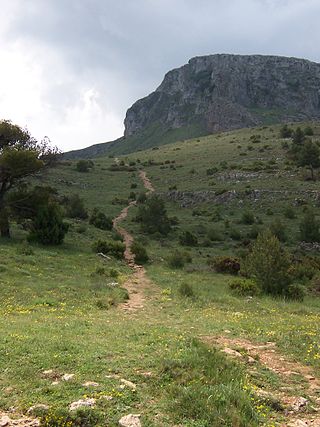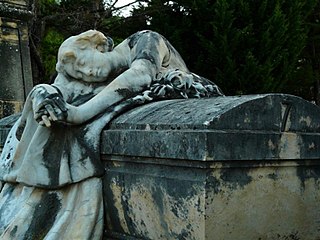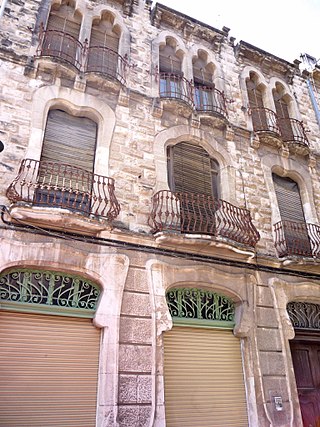
Alicante is a province of eastern Spain, in the southern part of the Valencian Community. It is the second most populated Valencian province. Likewise, the second and third biggest cities in the Valencian Community are located in this province.

Moros y Cristianos or Moros i Cristians literally in English Moors and Christians, is a set of festival activities which are celebrated in many towns and cities of Spain, mainly in the southern Valencian Community. According to popular tradition the festivals commemorate the battles, combats and fights between Moors and Christians during the period known as Reconquista. There are also festivals of Moros y Cristianos in Spanish America.

Cocentaina is a locality and municipality in the comarca of Comtat, in the province of Alicante, Spain. The village is located between the mountainous Serra de Mariola national park and the Serpis river. Cocentaina is ideally situated for both road and mountain biking. Many of the roads are used for training by professional teams, and several roads have been used by the Vuelta a España.

Muro de Alcoy or Muro d'Alcoi, also briefly called Muro is a town and municipality located in the comarca of Comtat, in the province of Alicante, Spain, lying at the foot of the Serra de Mariola. As of 2009, it has a total population of c. 8,900 inhabitants. The economy of Muro de Alcoy is based on textile industry, manufacture of plastic products and furniture and agriculture.

Llíria is a medium-sized town off the CV35 motorway to the north of Valencia, Spain. Known as Edeta in ancient Iberian times, it is the musical capital of the region. On October 30, 2019, Llíria was declared a Creative City in the category of Music by the UNESCO.

La Vall d'Uixó is a town situated in eastern Spain, in the Valencian province of Castelló. La Vall is located 25 km to the south of the province's capital Castelló, 45 km to the north of the community's capital Valencia and 8 km to the Mediterranean Sea, so it is at 118 m above sea level.

The Serra Mariola Natural Park is a mountain range in the Valencian Community, Spain, one of the most peripheral offsprings of the Baetic System. Most of its territory is included in a natural park founded in 2002, covering an area of 17,257 ha. The park is surrounded by the towns of Cocentaina and Bocairent and the cities of Ontinyent and Alcoy.

The Barxell Castle, located in the municipality of Alcoy, Alicante, Spain, is a 13th-century medieval building which stands on a rocky mound in the middle of a pine forest. It is next to the CV-795 road, between Alcoy and Banyeres de Mariola. It is located in the rural place of Barxell at 800 metres altitude. It is very close to the "Solanetes" which had a small population in the Muslim era.
Timoteo Briet Montaud was a Spanish architect, one of the main architects of the Art Nouveau in Alcoy and the Valencian Art Nouveau.

Vicente Juan Pascual Pastor was a spanish architect, one of the main architects of the Art Nouveau in Alcoy and the Valencian Art Nouveau.

Art Nouveau in Alcoy, as one of the main focuses of the Valencian Art Nouveau, is the historiographic denomination given to an art and literature movement associated with the Art Nouveau in Alcoy (Alicante), Valencian Community, in Spain.

Valencian Art Nouveau is the historiographic denomination given to an art and literature movement associated with the Art Nouveau in the Valencian Community, in Spain.

The Casa del Pavo is a private building at 15 Sant Nicolau Street, in the city center of Alcoy (Alicante), Valencian Community, Spain. It is one of the main works of the Art Nouveau in Alcoy.

The Circulo Industrial de Alcoy(Alcoy's Industrial Circle) is a cultural institution from Alcoy (Alicante), Valencian Community, Spain, founded on January 1, 1868. It is placed at 19 Sant Nicolau street, in the city center of Alcoy.

The Casa Laporta(Laporta house) is a private building at 26 País Valencià avenue, in the city center of Alcoy (Alicante), Valencian Community, Spain. It is one of the main works of the Art Nouveau in Alcoy.

The Casa d'Escaló(Escaló house) is a public building at 2 Joan Cantó street, in the city center of Alcoy (Alicante), Valencian Community, Spain. It is one of the main works of the Art Nouveau in Alcoy.

The Cementerio de San Antonio Abad(transl. Saint Anthony Cemetery) or Cementeri d'Alcoi is a cemetery located in Alcoy (Alicante), Spain.

The Casa Vilaplana(Vilaplana house) is a private building at 8 Joan Cantó street in the city center of Alcoy (Alicante), Valencian Community, Spain.

The Casa Briet is a private building at 24 Sant Josep Street, in the city center of Alcoy (Alicante), Valencian Community, Spain.

Fernando Cabrera Cantó (1866–1937) was a Spanish painter and sculptor; whose themes ranged from the cheerful and satiric to the darkly morbid. He also did landscapes.






















